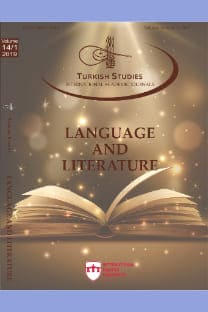Dijital Yayın Platformunda Sinkaflı Küfrün Türkçe Alt Yazısı: Sansür Var mı?
Turkish Subtitling of the F Word on the Digital Streaming Platform: Is There Censorship?
___
- Al-Yasin, N.F. & Rabab'ah, G. (2019). Arabic audiovisual translation of taboo words in American hip hop movies: A contrastive study. Babel, 65, 222-248. https://doi.org/10.1075/babel.00090.aly Andersson, L. G. & Trudgill, P. (1990). Bad Language. Penguin Books.
- Beseghi, M. (2016). WTF! Taboo language in TV series: An analysis of professional and amateur translation. Altre Modernita, 215–231. https://doi.org/10.13130/2035-7680/6859
- Bryson, B. (1991). The mother tongue: English & How It Got That Way. Avon. Chen, C. (2004). On the Hong Kong Chinese Subtitling of English Swearwords. Meta, 49(1), 135– 147. https://doi.org/10.7202/009029ar
- Chou, I. (2019). The under-translation and self-censorship in English-Chinese subtitling. T&I Review, 9(), 29-51. https://doi.org/10.22962/tnirvw.2019.9..002
- Díaz Cintas, J. & Remael, A. (2007). Audiovisual Translation: Subtitling (1st ed.). Routledge. https://doi.org/10.4324/9781315759678
- Eldalees, H., Al-Adwan, A. & Yahiaoui, R. (2017). Fansubbing in the Arab world: modus operandi and prospects. Arab World English Journal for Translation and Literary Studies, 1(1), 48–64. https://doi.org/10.24093/awejtls/vol1no1.4
- Fernández Dobao, A. M. (2006). Linguistic and cultural aspects of the translation of swearing: The Spanish version of Pulp Fiction. Babel, 52(3), 222–242. https://doi.org/10.1075/babel.52.3.02fer
- Díaz-Pérez F.J. (2020). Translating swear words from English into Galician in film subtitles: A corpus-based study. Babel, 66(3), 393 – 419. https://doi.org/10.1075/babel.00162.dia
- Harsanto, R.H. (2015). The Indonesian Translation of Swearing Word in the Wolf of Wall Street: A Study of Its Purpose and Effect [Undergrad Thesis] https://repository.usd.ac.id/861/2/114214032_full.pdf
- Jay, T. & and Janschewitz K. (2008). The pragmatics of swearing, Journal of Politeness Research, 4 (2), 267–288. https://doi.org/10.1515/JPLR.2008.013
- Khoshsaligheh, M. & Ameri, S. (2014). Translation of taboos in dubbed American crime movies into Persian. T&I Review, 4(2), 25-50. https://doi.org/10.22962/tnirvw.2014.4..002
- Kuscu-Ozbudak, S. (2021): The role of subtitling on Netflix: An audience study, Perspectives. https://doi.org/10.1080/0907676X.2020.1854794
- Ljung, M. (2011). Swearing: A Cross-Cultural Linguistic Study. Houndmills Basingstoke: Palgrave Macmillan.
- Manchon, P. G. (2013). A corpus-based analysis of swearword translation in DVD subtitles and Internet fansubs [Unpublished master’s thesis]. https://eprints.ucm.es/id/eprint/23201/1/Paula_Garcia_Manch%C3%B3n_%282%29.pdf
- McEnery, A. & Xiao, Z. (2004). Swearing in Modern British English: The Case of Fuck in the BNC. Language and Literature, 13(3), 235–268. https://doi.org/10.1177/0963947004044873
- Nguyen, T.M.K. (2015). Well, Fuck! A Comparative Case Study in DVD Subtitling: The Linguistic Transfer of Taboo Language in Reservoir Dogs from English into Dutch [Master’s Thesis]. https://dspace.library.uu.nl/handle/1874/319187
- Nikolic, K. (2019). The Language of Interlingual Subtitles: Studying the f Word in Skins. International Journal of Language, Translation and Intercultural Communication, 8, 48- 64. https://doi.org/10.12681/ijltic.20276
- Öztürk, F. (2019, August 2). Netflix: RTÜK'ün internet yönetmeliği ne getiriyor, kurul üyeleri ne diyor?. https://www.bbc.com/turkce/haberler-turkiye-49193378
- Pujol, D. (2006). The Translation and Dubbing of ‘Fuck’ into Catalan: The Case of From Dusk till Dawn. The Journal of Specialised Translation, 6, 121–133. https://www.jostrans.org/issue06/art_pujol.pdf
- Purnomo, SF., L. A., Pratama, I. D., Untari, L., Purnama, SF. L. S., & Anggraini, N. (2020). Revisiting euphemisation strategies for English to Indonesian subtitle context. Journal on English as a Foreign Language, 10(2), 222-245. https://doi.org/10.23971/jefl.v10i2.1480
- Pušnik, B. (2016). Translation of swearwords and vulgarisms in the animated movie south park. [Graduation Thesis] https://dk.um.si/Dokument.php?id=92579&dn=
- Santaemilia, J. (2019) A reflection on the translation of sex-related language in audio-visual texts: the Spanish version of J.K. Rowling’s The Casual Vacancy, Perspectives, 27(2), 252-264. https://doi.org/10.1080/0907676X.2018.1476563
- Scandura, G.L. (2004). Sex, lies and TV: Censorship and subtitling. Meta, 49(1), 125–134. https://doi.org/10.7202/009028ar
- Trupej, J. (2019). Avoiding Offensive Language in Audio-visual Translation: A Case Study of Subtitling from English to Slovenian, Across Languages and Cultures, 20(1), 57-77. https://doi.org/10.1556/084.2019.20.1.3
- Valdeon, R.A., (2019). Swearing and the vulgarization hypothesis in Spanish audiovisual translation, Journal of Pragmatics, https://doi.org/10.1016/j.pragma.2019.09.005
- Wajnryb, R. (2005). Expletive Deleted: A good look at bad language. Free Press.
- ISSN: 2667-5641
- Yayın Aralığı: 4
- Başlangıç: 2006
- Yayıncı: ASOS Eğitim Bilişim Danışmanlık Otomasyon Yayıncılık Reklam Sanayi ve Ticaret LTD ŞTİ
Mitik Trajik’ten Modern Trajik’e Bireyin Döngüsü: Edip Cansever’in “Medüza” Şiiri Üzerine
Mitolojik Kökenli Doğaüstü Varlıkların Deyimlere Yansıyan Özellikleri
Hint Mitolojisindeki Sarasvati’den Klasik Türk Şiirindeki Zühre’ye
Dijital Yayın Platformunda Sinkaflı Küfrün Türkçe Alt Yazısı: Sansür Var mı?
Klasik Türk Şiirinde Gelenek Çizgisi Dışında Âşık ve Sevgilinin Yeri
Yabancılara Türkçe Öğretiminde Efsane Türü Metinlerden Hareketle Kültür Aktarımı
Hakan Bıçakçı’nın Doğa Tarihi Adlı Romanında Öz Sömürü ve Şiddet
